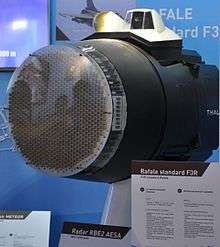RBE2
The RBE2 (Radar à Balayage Electronique 2 plans) is a multirole radar developed during the 1990s for the French Dassault Rafale combat aircraft.

While the RBE2 uses a passive electronically scanned array (PESA) the RBE2-AA radar system is an active electronically scanned array (AESA) radar system derived from the Rafale's RBE2 radar. It replaces the mechanically steered array antenna by electronically steering exerted by up to several thousand of transmit-receive modules which enable maximum performance and versatility as well as enhanced reliability. The improved RBE2-AA radar system is available since 2012 for the Rafale fighter-aircraft owned by the French Air Force, Navy and export customers. In April 2002, the French weaponry procurement agency (DGA) awarded Thales a contract to develop an active electronically scanned array (AESA) radar demonstrator based on the RBE2 radar system.
The RBE2-AA (active array) variant has been tested on a Mystère 20, a Mirage 2000 testbed aircraft from the Flight Test Center of the DGA (Délégation Générale pour l'Armement, the French procurement agency) and then on a Rafale. While the first tests were made with US-made transmitter-receivers, the current radar features parts manufactured by Thales. The radar is using about 838 GaAs T/R modules.
In July 2004, DGA awarded a 90 million-euro contract for the development of a second active electronically scanned array (AESA) radar demonstrator aimed at fielding this new technology on French Rafales beginning in 2012.
All radar functions are performed in the same flight:[1]
Characteristics
- Air defence
- Very long detection and track ranges
- Fully automatic, sorting and ranking of tracked targets
- Fully target tracks independent of search volume.
- Deep low-level penetration
- Automatic terrain following and avoidance
- Strike mission
- En Route update of target area situation
- High resolution imagery modes (SAR) - Designations
- Sea-skimming attacks
- Detection and multi-tracking
Active electronic scanning makes it possible to switch radar modes quickly, thereby enabling operational functions to run simultaneously.
Technical features
- Antenna block
- Active electronic scanning
- Very low side and scattered lobes in azimuth and elevation
- Very high reliability (T/R modules)
- Active transmit-receiver modules and exciter-receiver
- Multipole waveforms
- Coherent X band frequency generation
- Excellent spectral purity
- Wide bandwidth
- Full monopulse
- MMIC/GaAs technologies
- Programmable signal processor and data processor
- Target detection and ECCM processing
- Fully programmable
- Anti-obsolescence solutions: open architecture - COTS components
- Tracking computation
- High resolution map generation
See also
References
- "Active Electronically Scanned Array Radar - Thales Group". thalesgroup.com. Archived from the original on 18 November 2015. Retrieved 18 November 2015.
Brochure https://www.thalesgroup.com/sites/default/files/asset/document/aesa_rbe2_5_juin_val_def_bat_ok.pdf